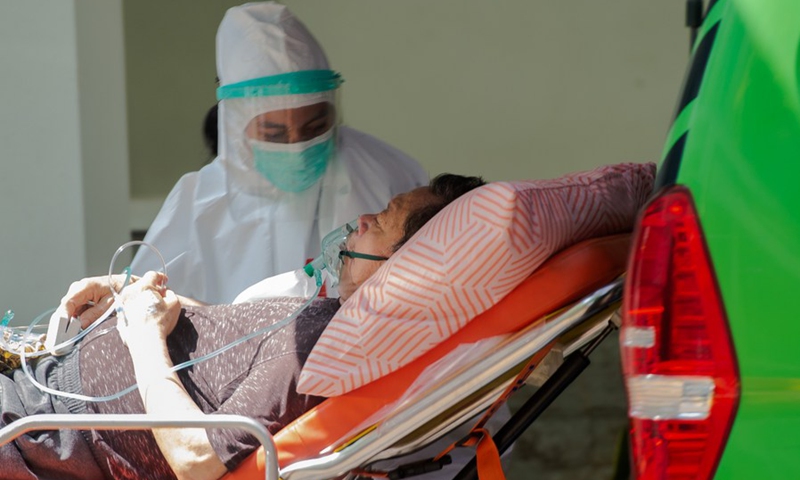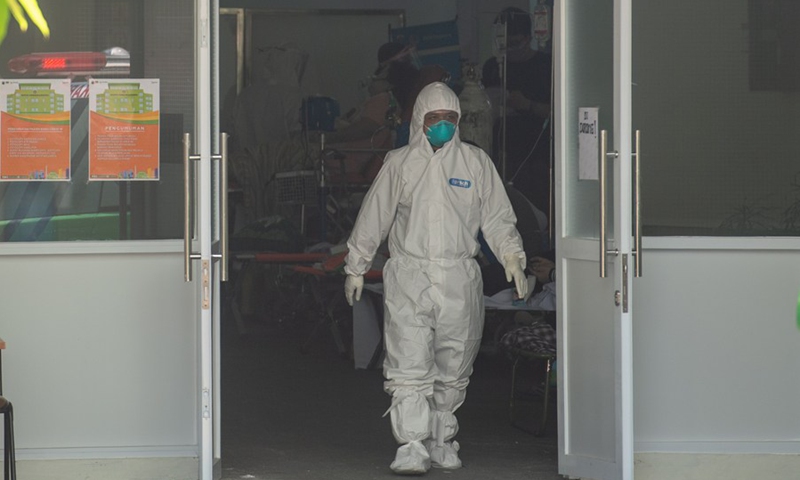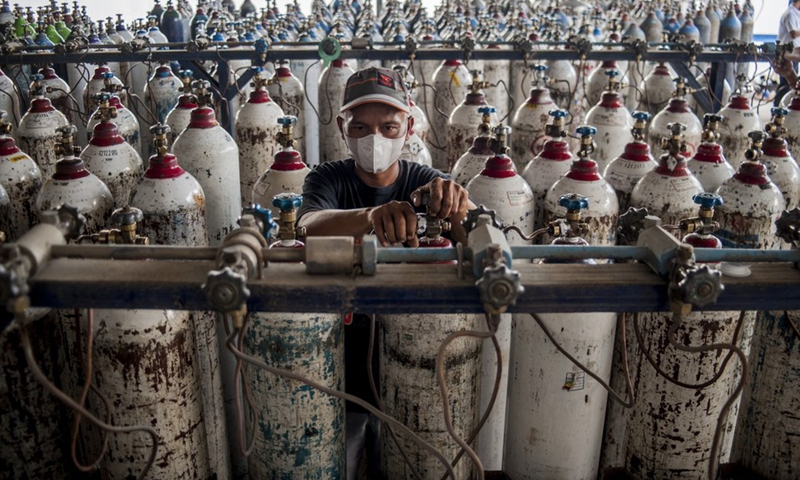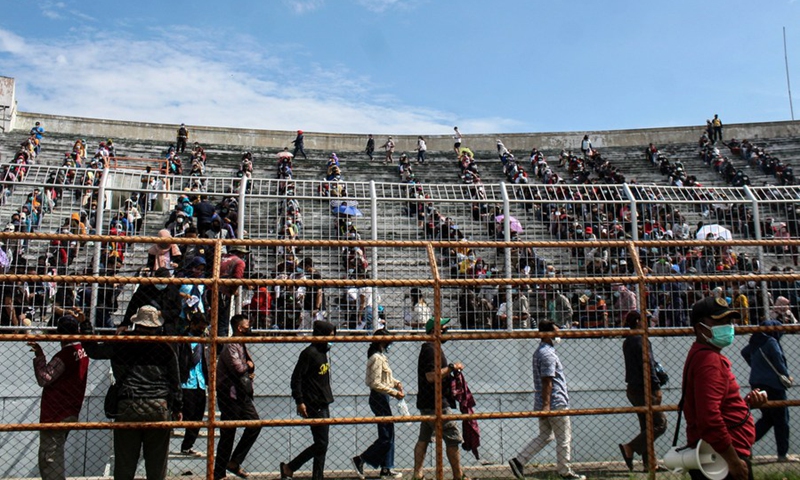
A patient arrives at the COVID-19 emergency room of Cengkareng Regional Public Hospital in Jakarta, Indonesia, July 9, 2021.(Photo: Xinhua)

A medical worker with protective suit walks out from the COVID-19 emergency room of Cengkareng Regional Public Hospital in Jakarta, Indonesia, July 9, 2021.(Photo: Xinhua)

A worker wearing a face mask is seen among medical oxygen tanks in Yogyakarta, Indonesia, July 7, 2021.(Photo: Xinhua)

People wait in line to receive COVID-19 vaccines during mass vaccination at Gelora Sepuluh November Stadium in Surabaya, East Java, Indonesia, July 10, 2021.(Photo: Xinhua)
Indonesia is facing a shortage of medical oxygen as many hospitals across the country are in dire need of such an essential therapeutic substance to cope with the overwhelming number of COVID-19 patients.
Oxygen supplies to hospitals in Indonesia are in scarcity as the number of COVID-19 cases continues to surge, and some of them have to close their doors to new patients with respiratory distress.
The COVID-19 cases in Indonesia rose by 35,094 in the past 24 hours to 2,491,006, with the death toll adding by 826 to 65,457, the Health Ministry said on Saturday.
The Indonesian Association of Public Health Experts (IAKMI) has predicted that in June and July there would be a significant increase in the number of COVID-19 cases.
"The increase in cases and the oxygen scarcity are due to the government's inability to predict and anticipate the situation," Hermawan Sapura, a member of the IAKMI Expert Council, told the Kompas daily.
The increase was measured by several factors, namely the massive crowds due to major national holidays, the euphoria of a nationwide vaccination drive and also the disobedience of people who were tired of practicing health protocols.
From early June to early July, at least 324 people died as they had to make self-isolation at homes with inadequate health facilities, according to LaporCovid-19, a coalition of people to share information about COVID-19, recently.
"People flocked to hospitals, which became full and overwhelmed, running out of oxygen, so that many died outside the hospitals. Health facilities have collapsed," Said Fariz Hibban from LaporCovid-19 said.
According to Secretary General of the Indonesian Hospital Association (Persi) Lia Gardenia Partakusuma, several factors have caused the crisis of oxygen stockpile in the country.
The first is the high demand for oxygen in hospitals, which is skyrocketing with the spike in the number of COVID-19 patients, she pointed out.
"For example, one hospital usually needs three tons of oxygen for three days to a week, but now it runs out in one day. There is even an increase of up to five times from before," she said, adding that the oxygen demand in the capital Jakarta as well as in West Java and Banten provinces is 750 to 800 tons per day, whereas in normal times it was only around 150-200 tons.
The nearly five-fold increase is not matched by the ability to deliver oxygen from distributors to hospitals, she added.
What's more, the lack of oxygen stockpile is caused by the limited number of tubes which are not easy to produce. As a result, oxygen cylinders become scarce and expensive.
"Another problem is that there are people who are not sick, but they just keep oxygen tubes at homes. Some even keep oxygen stocks of up to four tubes. That will affect small clinics that need oxygen cylinders because they are so scarce," she said.
Coordinator for the implementation of the emergency public activity restrictions (locally known as PPKM) Luhut Binsar Pandjaitan admitted at a press conference on Tuesday that the oxygen supply was insufficient to meet the needs.
Luhut, who is also the Coordinating Minister for Maritime and Investment Affairs, said the current availability of oxygen based on calculations is capable of serving 5,000 cases per day, or even 60,000-70,000 cases per day if the worst happens.
He also explained that the government has diverted 100 percent of industrial oxygen for health.
"We order that this oxygen is purely used to help people who are isolated and in intensive care. While for the ones with mild symptoms, we use oxygen concentrators," the minister added.
Luhut further said the government has prepared for a worst-case scenario if the number of COVID-19 cases increases to 40,000 or more with supplies of oxygen and medicines to hospitals.
Industry Minister Agus Gumiwang has consulted with the Indonesian Industrial Gas Association (AGII) to ensure the supply of medical oxygen gas to hospitals which treat COVID-19 patients.
"I have coordinated with the association and they are committed to maintaining the supply of oxygen to hospitals in the midst of rising demands due to the increase in COVID-19 cases," Gumiwang told CNNIndonesia.com on Wednesday.
